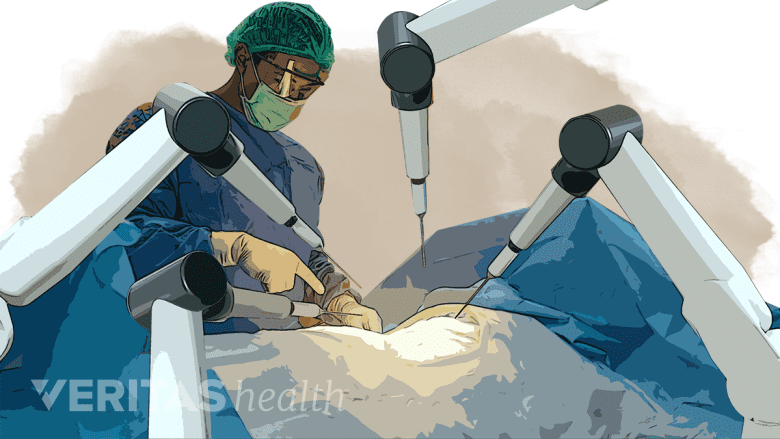Treatment for an abdominal aortic aneurysm largely depends on the likelihood that complications will arise. There are two methods for treating an abdominal aortic aneurysm:
- Nonsurgical treatments and regular monitoring are used for abdominal aortic aneurysms that have a low risk of rupture. There is no way to reverse the damage.
- If an abdominal aortic aneurysm is not found until it is an emergency, treatment requires emergency surgery to repair the ruptured artery. An abdominal aortic aneurysm is considered an emergency if it has ruptured or has a high chance of rupturing.
If a rupturing abdominal aortic aneurysm has been diagnosed, some treatment or management is necessary for preventing fatal internal bleeding.
In This Article:
- Abdominal Aortic Aneurysm
- Abdominal Aortic Aneurysm Symptoms
- Abdominal Aortic Aneurysm Causes
- Abdominal Aortic Aneurysm Treatment
Cardiac Care for Abdominal Aortic Aneurysms
Lifestyle changes and medications are advised after surgery.
For a low-risk case, a physician will likely advise lifestyle changes or medication to slow the development of an aneurysm. Small, low-risk aneurysms are usually monitored by ultrasound every 6 to 12 months to check the size and assess for growth of the artery.
Medications to lower blood pressure and cholesterol level may be prescribed to limit the amount of plaque buildup in the aorta and to reduce pressure on the arterial walls.
Eliminating tobacco and nicotine intake (dip, chew, vapor) is the most important thing a patient can do to minimize the chance of aortic rupture. Other important lifestyle changes include maintaining a healthy diet and getting regular exercise, which help lower blood pressure and cholesterol levels and in turn can decrease the chance of rupture.
Surgery for Abdominal Aortic Aneurysm
Open surgery is a common approach for treating abdominal aortic aneurysm.
The goal of surgical abdominal aortic aneurysms treatment is to stop a rupture if the artery is leaking blood or to prevent a rupture from developing. Surgical repair requires replacing the damaged part of the aorta with a stent graft, an artificial artery made from a high-tech fabric with a supportive mesh wire frame.
The two standard surgical treatments for abdominal aortic aneurysms are:
Open Surgery
The traditional treatment for abdominal aortic aneurysm ruptures or impending ruptures is an open repair surgery, in which the enlarged portion of the aorta is removed and replaced. An open surgery for abdominal aortic aneurysms repair consists of the following:
- An incision is made in the abdomen near the site of the aneurysm.
- The aorta is clamped and blood is temporarily stopped from flowing through the damaged portion of the aorta.
- The damaged part of the aorta is removed.
- A tube graft (like a garden hose) is inserted where the damaged portion of the artery was removed and is sewn into place.
Open repair is the most common surgical treatment for abdominal aortic aneurysms. If damage to the aorta does not require the artery’s removal and full replacement, less invasive options are available and generally recommended.
Endovascular Aneurysm Repair
An endovascular aneurysm repair (EVAR) surgery is less invasive than open surgery, and requires neither a large abdominal incision nor removal of the damaged arterial walls. Endovascular surgery also does not require blood flow through the aorta to be stopped, placing less stress on the heart than open surgery.
Endovascular surgery involves the following process:
- Two small incisions are made in the groin.
- A catheter is inserted into an artery in the groin, called the femoral artery, and guided to the abdominal aorta.
- Through the catheter, a stent graft is led to abdominal aortic aneurysm. Until the stent graft reaches the aneurysm, it is compressed and closed.
- The stent graft is put into position in the damaged portion of the aorta, and the wire frame is expanded to fit the artery’s natural size.
- The stent graft is then sewn or secured into place at either end of the damaged area of the artery.
- Once the stent is in place, blood redirects from the expanded portion of the artery and flows only through the stent graft. This takes pressure off the arterial walls and may allow them to reduce in size over time, decreasing the risk of rupture.
Endovascular surgery uses a live X-ray to allow the surgeon to view the repair without making a large incision, and to guide the stent into place.
This procedure is not available to patients whose aorta cannot safely be accessed through the femoral arteries, or whose artery is so damaged that the aneurysmal section must be replaced.
There is some debate over the advantages endovascular repair may have over open repair. While many advocates of the procedure suggest that its minimally invasive nature makes endovascular surgery the better option, studies show little long-term advantage when it comes to continued complications and mortality rate.1Patelis N, Moris D, Karaolanis G, Georgopoulos S. Endovascular vs. Open Repair for Ruptured Abdominal Aortic Aneurysm. Med Sci Monit Basic Res. 2016;22:34-44. In some cases, the aneurysmal problem is so big or complicated that an open repair gives better results.
Post-Surgical Care After Abdominal Aortic Aneurysm Surgery
Follow-up monitoring is typically necessary after any aneurysm repair surgery to ensure the stent is working and the aorta functions without a high risk of rupture. Patients will also likely be advised to maintain a healthier heart and cardiovascular system by making changes to diet, exercise, and smoking habits, or by taking medication to control cholesterol and blood pressure.
- 1 Patelis N, Moris D, Karaolanis G, Georgopoulos S. Endovascular vs. Open Repair for Ruptured Abdominal Aortic Aneurysm. Med Sci Monit Basic Res. 2016;22:34-44.







